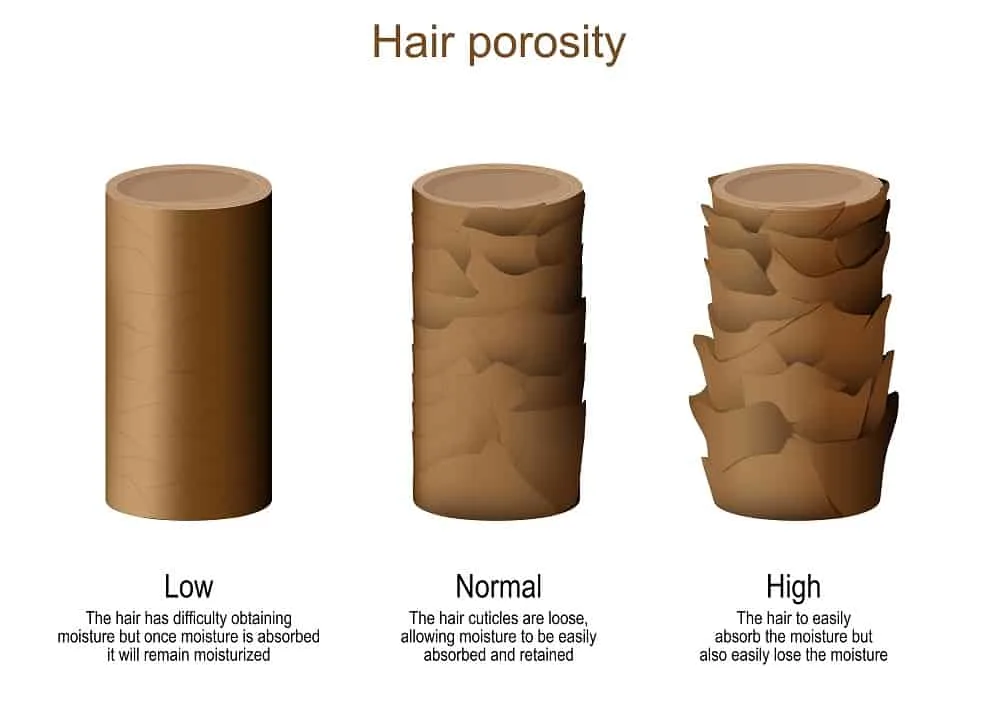There is a big difference between high porosity hair and low porosity hair, and you need to know all the particularities if you want to grow your hair faster and keep it healthy, with a marvelous glow.
But let’s start from the beginning! What is high porosity hair or low porosity hair? Do you have these types of hair? What causes them? We will answer all of your questions and help you get a hair routine that fits your strands.
High Porosity Hair

High porosity hair takes in moisturizers very quickly, but, unfortunately, it loses them rapidly. In some cases, this problem it’s hereditary, but mostly, it’s caused by all the chemicals we apply on our strands.
That includes bleaching, color treatments, using all sorts of irons, hairdryers, and even the sun. They all have an adverse outcome on your threads.
To better understand what is happening to your hair, you must know that each thread has three layers: cuticle, cortex, and medulla. When having high porosity hair, those cuticles are too far apart, so the moisturizer gets in quickly, but it doesn’t have time to do its job because it comes out as fast as it got in.
When this happens, the thread is not moisturized enough, and it will frizz, tangle, and look dry even if you applied nourishing products.
But don’t panic, there are ways you can deal with this problem and get gorgeous hair! Protein treatments are your best friends because they fill those dense pores. Use them once a month, and the results will be noticeable.
Also, opt for a shampoo and conditioner that contains no sulfates, silicones or parabens and insert oil and butter in your hair routine.
There are also a few sealing oils that will do an astonishing job: castor oil, grapeseed oil, or jojoba oil. Butter is also a good option, they highly nourish and moisturize, but they are harder to spread on your strands.
Hair Care For Highly Porous Hair
Highly porous hair, on the other hand, has different care requirements. Here are a few tips to help heal your high porosity hair and keep your locks healthy and hydrated.
- Avoid harsh chemicals such as bleaches and artificial color treatments
- Use protein treatments to help build back cuticle strength
- Butters and natural oils are your friends
- Deep condition your hair regularly
Low Porosity Hair

At the other pole, you can find the low porosity hair. Remember those cuticles we talked about? In this case, there is no space between them, so the moisturizers or water can’t get inside.
It’s like hair tries to repeal everything that wants to pass in. All the products you apply remain on the hair and don’t get soaked.
However, there are a few tricks you can do to change hair porosity! Consider using heat caps when moisturizing the hair; this way, all the nourishing products will get absorbed.
Oils, butters, and silicones are not a good option for low porosity hair, use only light, refreshing sprays and shampoos without moisturizers. Clarifying shampoos are also ideal products for this hair type.
Low Porosity Hair Care
Here are a few tips for taking care of your low porosity hair. While you cannot completely change your hereditary hair type, it is possible over time to improve your hair’s health by following a few rules.
- Use a clarifying shampoo two or three times a week
- Avoid butter, oils, silicones, and other heavy products that will weigh down your hair
- Avoid treating your hair with protein products
- Use water-based and lightweight products
High Porosity Hair Vs. Low Porosity Hair

Here are 7 differences between high and low porosity hair shown below in a high porosity hair vs low porosity hair comparison table.
| High porosity hair | Low porosity hair |
| Moisturizers penetrate the cuticles easily but also get out quickly | Moisturizers hardly penetrate the cuticle |
| Cuticles are far apart | Cuticles are sealed |
| Caused by chemicals, bleaches, color treatments | Hereditary |
| Easy to style | Hard to style |
| Use deep conditioning | Use light conditioning |
| Use protein treatments | Don’t use protein treatments |
| Hair dries fast | It takes a lot of time to dry the strands |
Frequently Asked Questions
This section will cover some of the most frequently asked questions about high and low porosity hair.
Genetics is the most significant culprit that causes low porosity of hair. High porosity hair, on the other hand, can also sometimes be hereditary.
More often, however, it is developed over time by treating hair with chemicals like bleach, hair color, and other chemicals.
Neither high nor low porosity hair is inherently better than the other. Each has advantages and disadvantages and can be managed with proper care and the right products.
Medium porosity hair is ideal. This hair type is known for porous cuticles to allow moisture in but tight enough to keep the hydration secured.
How frizzy your hair is, does not have much to do with whether you have low or high porosity hair. Low porous hair does tend to be quite dry because moisture cannot penetrate the cuticles to hydrate the hair.
High porosity also runs the risk of hair becoming dehydrated and frizzy. Although moisture can quickly enter the cuticle, it also easily leaves.
How frequently you need to wash your hair depends on hair porosity. Generally, low porosity hair needs cleaning more often to help manage product build-up. A thorough cleaning two or three times per week will keep your locks looking fresh.
You can go a bit longer between washes for those with high porosity hair. Aim to wash your hair once weekly with a gentle, sulfate-free shampoo for a healthy scalp and hair.
Many people struggle with growing out their high porosity hair. Frequently, its weak structure and chemical damage mean that it undergoes a lot of breakages that prevent sustainable growth.
Unfortunately, a similar problem occurs in low porosity hair. Since this hair type is naturally drier, it is typically brittle and may break before it can grow
Hair porosity is an excellent indicator of your hair care routine, which you have to consider. Take a glass of water and a thread from your brush. Place the thread on the surface and observe how fast it sinks. If it floats, you have low porosity hair; if it sinks quickly, opt for hair care for high porosity hair.
It is essential to give your strands the nourishing that they need because you can get a ravishing mane using the tips presented above.
